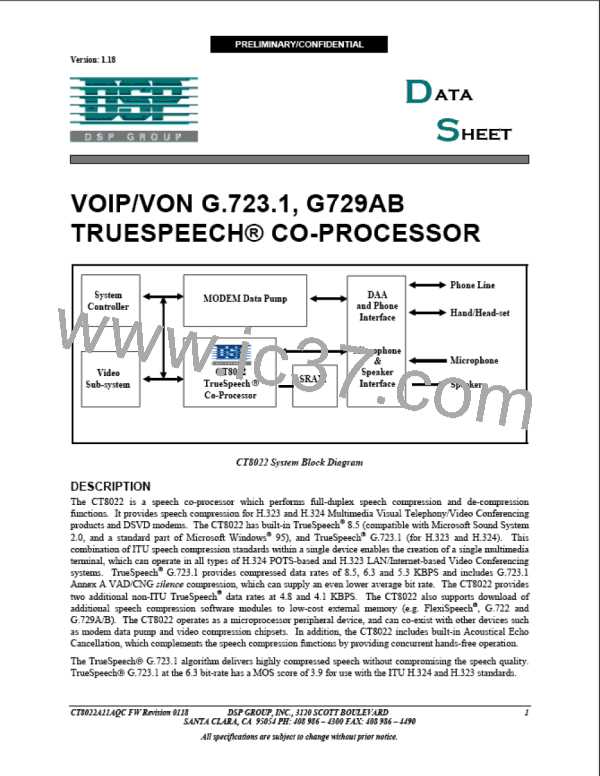Version: 1.18
PRELIMINARY/CONFIDENTIAL
TrueSpeech® Co-Processor
7 Play & Record Delay Management
7.1 Delay and Latency Management
The CT8022 has features that allow the Host to manage and control the amount of delay and latency provided by the
CT8022. The CT8022 includes data buffering in both the playback and record channels that allows the Host to
operate with relaxed timing requirements when transferring data to or from the device. Internally, the CT8022
operates within a strict single-frame 30ms time limit when compressing and decompressing speech frames in
real-time. The CT8022’s buffering capabilities allow the Host to operate with programmable additional latency so as
to avoid requiring the Host to perform data transfers that are synchronized exactly to the 30ms frame period. By
programming the buffer depth for the record and playback channels, the Host can select the trade-off made between
the time allowed for the Host to respond to a request for data transfer and the amount of delay introduced. Further,
the Host is able to manage any accumulation of data, which causes additional delay that results from differences in
precise clock rate between the two ends of a speech link.
7.2
Data Over-run And Under-run
Data over-run occurs when data arrives at a point faster than data departs from that point. Data under-run occurs
when data attempts to leave a point faster than it arrives. In addition to providing buffer depth management support
functions such as buffer depth monitoring and variable buffer depth control for Host-based buffer management, the
CT8022 has a built-in or default buffer management scheme. When the Host allows the record (receive) buffer to
over-run, the CT8022 responds by simply discarding frames until the Host causes the record buffer to be less than
full. When the Host allows the playback (transmit) queue to become empty, the CT8022 responds by repeating the
last frame until new data becomes available.
7.3
Buffer Monitoring
The CT8022 provides buffer monitoring functions that allow the Host to determine at any time the amount of speech
data in the device's transmit and receive queues.
7.4
Frame Creation and Deletion
The CT8022 provides frame creation and deletion commands to allow the Host to dynamically control the transmit
and receive speech channel delays. The frame creation function causes the CT8022 to create an extra frame
(provided the relevant queue is not full) by duplicating the most recent frame. The frame deletion function causes
the CT8022 to discard the most recent frame from its receive or transmit buffers (assuming the buffers are not
empty). These functions are an essential part of managing a full-duplex communications link for two reasons.
The first reason is that, since the clock rates at the two ends of the link will always be fractionally different, one end
of the link will tend to accumulate data, progressively increasing the end-to-end delay. The other end will consume
data more quickly than it arrives. This causes any intentional delay or speech buffer created by the Host, for the
purpose of smoothing or averaging out of the data transmission rate, to be gradually consumed, until the link
operates with zero delay.
The creation and deletion functions allow the Host to monitor the buffer depths continually, and introduce periodic
corrections to the overall effective data rate to keep the buffers filled to the desired depth. For example, if the Host
detects that the transmit buffer depth has become too low, it can correct this by instructing the CT8022 to create an
additional frame.
The second reason is that, since the communications link connecting the two ends of the speech channel may be
prone to occasional errors or data corruption, speech frames will be lost or damaged from time-to-time, and thus
discarded. This has the same effect as the data under-run process. Again, the Host can use the frame create function
to make up for the lost frames. If the Host-to-Host link includes error correction, this second issue will not be a
problem.
CT8022A11AQC FW Revision 0118 DSP GROUP, INC., 3120 SCOTT BOULEVARD
SANTA CLARA, CA 95054 PH: 408 986 – 4300 FAX: 408 986 – 4490
47
All specifications are subject to change without prior notice.

 ETC [ ETC ]
ETC [ ETC ]